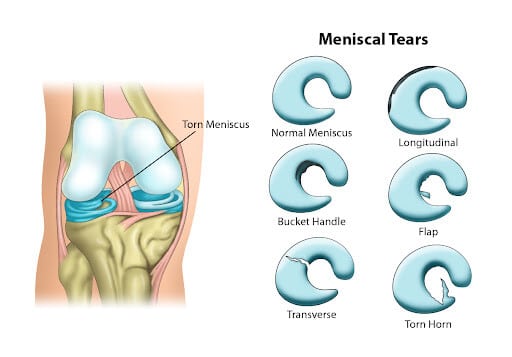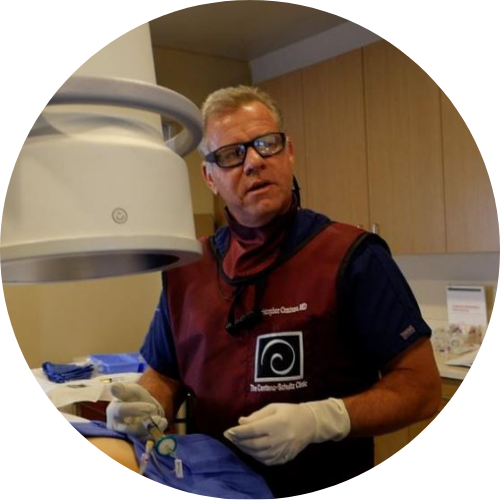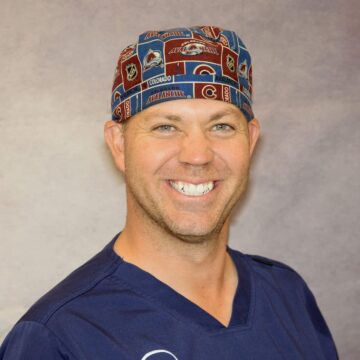Radial Meniscus Tears
The meniscus is an important fibro-cartilage structure within the knee that absorbs shock and provides cushioning. It has a semicircular ‘C’ shape and sits between the femur (thigh bone) and the tibia (lower leg bone).
The meniscus protects the two bony structures from weight, shock, and shear forces. Each knee contains two menisci, one on the outside (lateral) and one inside (medial).

Due to its near-constant exposure to compacting forces, the meniscus is susceptible to injury, particularly meniscal tears. The most common type of meniscal tear is a radial meniscus tear, which refers to tears that occur along its radius. This is commonly caused by sports injuries or a sudden impact, but can also occur through normal wear and tear as we age.
Radial meniscus tears can result in painful, debilitating symptoms that may have an impact on your quality of life. If left untreated, a meniscus tear might also cause further degenerative changes to the knee joint, causing long-term (chronic) knee disability.
What Is A Radial Meniscus Tear?
Radial meniscus tears are distinguished by a left-to-right tear that originates from the center of the meniscus cartilage and extends outward toward its bordering edge. This is especially harmful because the tear runs across the fibers of the meniscus cartilage, separating it and weakening its structure.
As the structural integrity of the meniscus deteriorates, so does its ability to absorb shock and shear forces adequately. This can result in pain, swelling, or restricted movement, limiting the knee’s overall ability to function normally.
Furthermore, the majority of the meniscus is surrounded by lubricating ‘synovial’ fluid, but only a small portion of the meniscus has an adequate blood supply. A radial meniscus tear develops in the “white zone”, the area of the meniscus with the least amount of blood flow.
As a result, this low blood flow area is deprived of critical healing elements, limiting its ability to heal. Comparatively speaking, a horizontal meniscus tear occurs where there is an adequate blood supply and a much higher chance of healing naturally. This indicates that radial meniscus tears may be difficult to heal naturally without the help of complementary therapies.
Symptoms Of Radial Meniscus Tears Tears
A variety of signs and symptoms can indicate a radial meniscus tear. Because these may be similar to those of other knee disorders or conditions, it is important to be assessed by a certified physician for an accurate diagnosis.
Signs and symptoms may present within 24 hours after the initial injury, or they can develop over time. You may experience any of the following:
Pain And Swelling
Knee pain and swelling appear as a result of tissue damage and inflammation caused by the radial meniscus tear. Sharp or jarring pain is typically described during knee movement or when attempting to bear weight. Pain can occur around the inside, outside, or back of the knee.
Swelling may occur throughout the knee and is a direct result of damaged structures and blood vessels. It’s recommended to see a certified physician if pain or swelling appear around the knee joint, particularly if it limits the range of motion or ability to bear weight.
Mechanical Symptoms (Popping, Clicking, Catching, And Locking)
A radial meniscus tear can lead to several mechanical issues that restrict the knee joint’s normal range of motion and functionality. When the meniscus tears, the cartilage can slip out of place, affecting how the knee joint moves and impairing its fluidity. There is a chance that some of the following mechanical disruptions will occur:
Popping Sensation In The Knee
A popping feeling may be felt when bending or twisting the knee because the torn meniscal cartilage can now move freely inside the knee joint. This causes the joint to roll over the damaged cartilage and produces a rolling or popping sensation.
Clicking, Catching, And Locking
A radial meniscus tear may also become obstructive or be pinched as the knee joint moves, restricting the range of motion. This results in a clicking or catching sensation, or in more extreme circumstances, a total locking of the joint’s ability to move further.
Symptoms Deep Dive
Back of Knee Swollen
Back of knee swollen? Swelling in the back of the knee is not something that is talked about too often. It can be uncomfortable or sometimes painful with the movement of the knee or, even with rest. It often stems from an orthopedic-related issue or, perhaps some other medical condition. Let’s dive in…What’s Causes Swelling in the Back of Your Knee? The back of the knee contains a variety of anatomical structures that can be affected and result in pain, swelling, numbness, tingling, etc. Muscles and tendons behind the knee that could be the source of pain or pathology could be one or more of the following: Gastrocnemius, Soleus…
Read More About Back of Knee SwollenBack of Knee Tight
Stiffness in the back of the knee can be a sign that there is damage or inflammation in the joint, arthritis, or a baker cyst. This might be due to an injury, overuse, or medical condition. If you are experiencing stiffness in your back knee, it is important to see a doctor determine the cause and get treatment. Common causes of stiffness in the back of the knee include: tight muscles, tendons, and ligaments, Injury to the joint or surrounding tissue, overuse such as from running or biking for long periods. Stiffness at night can potentially indicate damage to the joint…
Read More About Back of Knee TightBruising in Knee
Bruising in the knee, also known as a knee contusions, is an uncomfortable yet common condition that occurs when you strike your knee with force or a symptom of a knee condition. When the tiny blood vessels are damaged and blood leaks out beneath the skin, causing the typical swelling and red/purple discoloration seen in these injuries, it is termed a bruise or contusion. Although a knee contusion does not usually require medical intervention, you may need to visit your doctor to ensure that you do not have a more significant problem. If you hurt your knee and have swelling/pain that gets worse instead of better…
Read More About Bruising in KneeHamstring Pain Behind Knee
Hamstring pain behind the knee is a real problem, but many people are unaware of its severity. The hamstring muscle group spans the back of the thigh and consists of three muscles – Biceps Femoris, Semimembranosus, and Semitendinosus. Pain in the posterior aspect/backside of the knee has to do with one of three hamstring muscles. These can be roughly categorized as follows: Pain in the lower portion of the hamstring (semitendinosus and semimembranosus) is typically due to an injury sustained at their origin, or where they attach; this may be referred to as ‘insertional pain’. Pain located in the middle portion of the hamstring…
Read More About Hamstring Pain Behind KneeKnee Clicking
Clicking in the knee can occur for a number of reasons. The 5 major causes include: ligament injuries, meniscus tears, knee arthritis, patellofemoral syndrome, and soft/scar tissue. Let us start with ligament tears. A ligament is a thick piece of connective tissue that connects one bone to another. The knee has 4 principal ligaments: ACL, PCL, MCL, and LCL. Ligaments provide important stability for the knee (1). If injured or torn, ligaments can create instability. This instability can cause clicking in the knee. As ligaments travel across boney surfaces they can also catch make the knee click. The meniscus is a C-shaped cushion situated between the thigh bone and shin bone.
Read More About Knee ClickingKnee Hurts When I Bend It and Straighten It
Your knees bend countless times throughout the day. Running up the stairs, down the hall after kids, and getting into the car. You straighten the knee as you walk, descend stairs or get into and out of the car. Bending and straightening the knee are necessary for daily activities. Knee pain with bending or straightening may be a mild, transient irritation or may indicate a more significant problem. Learn more below and avoid further injury and dysfunction. Knee pain can vary significantly depending upon many factors including the actual source of the pain, the severity of the injury, general health, and level of activity…
Read More About Knee Hurts When I Bend It and Straighten ItKnee Locking & Catching
Knees have the ability to bend forward and back, as well as rotate slightly. When a knee is unable to execute these actions, it impairs mobility and the capacity to complete daily chores such as sitting, standing, squatting, or kneeling. A locked knee occurs when a knee cannot be bent or straightened so it gets stuck or feels locked in a certain position for an extended period of time. There are two forms of locked knees: one that is due to inability to move because of an actually physical or mechanical restriction and there is one that feels locked due to the pain involved in moving it. When a person has their knee joint effectively frozen into place and cannot move, this is known as a true locked knee….
Read More About Knee Locking & CatchingKnee Making Crackling Sound
Crepitus is the medical term for this cracking or catching sensation. It can affect various regions of the body, but it is most common in the knee. It can happen due to air bubbles forming in bodily tissues (this is what happens most of the time), but it can also happen as a result of patellofemoral syndrome, damaged cartilage, osteoarthritis, or other conditions. Patients describe the sound of the popping with the following terms: popping, snapping, catching, clicking, crunching, cracking, crackling, creaking, grinding, grating, and Clunking. When Should You Be Concerned? When the crackling is accompanied by pain and/or the feeling of instability in the knee, that’s a good time to consult a physician. If the cracking is also associated….
Read More About Knee Making Crackling SoundKnee Pain
Knee pain can be caused by many factors. Overuse injuries, direct trauma to the knee and arthritis are the most common causes of knee pain. Damage to the knee structures may cause swelling, scar tissue formation (fibrosis), and loss of function of the joint. Pain is often accompanied by difficulty walking, weakness, and instability. When the knee is overused, the thigh and shin bones (femur and tibia), cartilage, or tendons may experience stress. This leads to pain and discomfort as well as stiffness in the knee. Overuse injuries are common among athletes who participate in sports that involve running, jumping…
Read More About Knee PainKnee Popping
Knee popping can be a sensation that something is moving around in the knee. There may also be an audible sound associated with the popping, which in medical terms is called crepitus. This can also cause what we call mechanical catching or locking, which may make the knee feel like it is stuck in an extended or flexed position, and you have to move it in certain ways to get out of that. This knee popping sensation or sound or could be a very simple issue or it could be a sign that more serious damage is going on in the knee, so determining what is causing it is very important. So, the knees may pop and get in a certain position….
Read More About Knee PoppingKnee Swelling
Swelling of the knee, also known as water on the knee, is a condition in which fluid collects around the knee joint. Swelling can occur for a variety of reasons and affect patients of any age. Some swelling can be treated with over-the-counter medicines, but persistent and continuous swelling might result in tissue damage, bone softening, and cartilage deterioration. Over-the-counter medicines will assist relieve pain for individuals with a history of osteoarthritis and swelling following physical activity, such as exercise or running. During and after activity, the patient may apply compression sleeves to reduce the inflammation. Ice is another method…
Read More About Knee SwellingTightness in Knee
What could tightness in your knee mean? When fluid builds up inside the knee as a result of an injury, overuse, or medical problem, the knees become swollen and tight. Swelling might be mild, so you may not always notice it unless it is serious damage. You may feel this as stiffness in the knee since swelling may not be visible. Swelling restricts movement since there is less room in the knee. Fluid buildup can be caused by irritation, internal bleeding, and injuries to the knee. Arthritis, gout, tumors, and baker cysts are all causes of swelling. Pain and swelling are the responses of your body to damage. Together they can lead to stiffness in your knee…
Read More About Tightness in KneeCommon Causes Of Radial Meniscus Tears
Any activity that involves significant impact or stress on the knee joint can cause a radial meniscus tear. Degenerative changes and some medical conditions can also increase the risk of developing a meniscal tear. Some examples of these include:
Repetitively Or Suddenly Twisting The Knee
Meniscal tears may occur from repetitive or sudden twisting motions. For example, consider the sudden pivoting or twisting movements seen in high-impact sports, such as soccer or basketball. Similarly, even low-impact repetitive twisting movements performed over time may increase the risk of a radial meniscal tear.
Incorrect Landing From A Jump
When landing awkwardly or unevenly during high-impact running or jumping, the knee joint can move out of alignment while under significant force. Having forces impact the meniscus cartilage when it is out of optimal alignment may cause it to tear.
Degeneration Of The Cartilage
Some medical conditions, such as osteoarthritis, or long-term overuse of the knee joint can cause degeneration (wearing) of the meniscus. Meniscal degeneration can weaken its fibro-cartilage structure and increase the possibility of a radial tear.
Common Treatments For Radial Meniscus Tears
However, due to the location of radial meniscus tears and their poor blood supply, alternative options may be more beneficial for complete healing and recovery. To reduce recovery times and avoid risky procedures, it is important to prioritize more conservative therapies over invasive treatments. These include:
The R.I.C.E Method (Rest, Ice, Compression, And Elevation)
The recommended initial treatment for most injuries, including a radial meniscus tear, involves utilizing rest, ice, compression, and elevation (R.I.C.E.). Activating the R.I.C.E method as soon as an injury occurs can help decrease its severity, relieve pain and swelling, and reduce recovery times. The R.I.C.E method involves:
- Rest: Pain, discomfort, or swelling in the knee are your body’s warning signs that an injury has occurred. It is recommended to stop any physical activity, limit weight bearing, and rest the knee soon after the initial injury. This can help decrease swelling, prevent worsening the injury, and reduce the recovery time.
- Ice: The application of ice can help manage pain and swelling by slowing blood flow. It is best to place a towel or cloth between the ice and your skin to prevent a cold burn. Leave the ice on for no longer than 20 minutes at a time, and it is best to re-apply the ice every 2 hours within the first 24 hours of the initial injury.
- Compression: Using a compression bandage, wrap the knee until it feels firm and supported. Compressing the area will reduce bruising and swelling. It is important not to constrict the knee too tightly, as this will inhibit blood flow to the area. If your toes become white or blue and begin to feel numb, you should loosen the bandage and possibly seek medical help.
- Elevation: Keeping the knee elevated whenever possible will help reduce the painful symptoms caused by swelling and bruising. This can be done by using pillows or chairs to keep the knee just above or at the level of the heart.
Knee Brace
Wearing a knee brace may be recommended to stabilize the knee after a radial meniscus tear. A knee brace can offer support and stability, and even limit the knee’s range of motion while it heals. This may assist in relieving pain and reducing the risk of further injury. It is important that the brace is properly fitted by a health professional to prevent misalignment.
Physical Therapy
Physical therapy exercises aim to reduce swelling and re-mobilize the knee joint, easing stiffness and restoring muscle strength. Strengthening the muscles around the knee reduces stress on the meniscus, promoting normal knee function, stability, and range of motion.
Regenexx
Regenexx therapy is an alternative treatment for radial meniscal tears. It involves drawing a sample of your bone marrow, isolating the stem cells into a concentrated solution, and re-injecting this solution directly into the affected area of the knee.
All of the doctors at Centeno-Schultz use ultrasound and X-ray guidance to place the Regenexx injection precisely for the best and safest results. Due to stem cells’ ability to restore damaged tissues, this may aid in healing and strengthening the torn meniscus.
Regenexx mimics the body’s natural healing processes, helping to compensate for the limited blood supply of the meniscus. This helps reduce pain and inflammation as the damaged meniscus begins to heal itself.
Because Regenexx utilizes the body’s own regenerative properties, this negates the need for some medicines and more invasive surgical options, which also reduces side-effects and recovery time.
Surgical Treatments For Radial Meniscus Tears
If the radial meniscus tear is severe, or if conservative treatments are ineffective, a doctor may suggest a more invasive surgical treatment option. These are normally done by arthroscopy, through small incisions in the knee. The surgical procedure can vary depending on the tear’s severity and might include:
Surgical Repair
In an arthroscopic surgical repair, the surgeon uses fine instruments to mend the torn meniscus. This brings the torn cartilage back together using dissolvable tape or sutures.
Partial Meniscectomy
A partial meniscectomy procedure removes the damaged portion of the meniscus in an effort to restore normal knee function. This may help reduce pain and resolve problematic mechanical symptoms.
Total Meniscectomy
A total meniscectomy involves the complete removal of the entire meniscus. This is usually only recommended for severe radial meniscus tears or where there are associated complex degenerative changes. The goal of a total meniscectomy is to alleviate painful symptoms as well as the risk of further degeneration in the knee joint, which could lead to bone compromise.
Surgery does have its drawbacks and research does not supports its use: (1-5)
- Knee menisucs surgery patient are 3x more likely to need a knee replacement
- Knee meniscus surgery patients are no better than physical therapy to address knee pain
- Fake knee surgery was found to be as effective as real surgery
- Meniscal surgery found to provide no benefit for knee pain or locking
- Just because you have a meniscus tear, is not associated with knee pain
Who Is At Risk Of This Condition?
A meniscus tear is more likely to occur during high-impact activities that involve compression and shearing (twisting and bending) forces to the knee. For example, some athletes are at a greater risk of meniscal tears due to the nature of the sport, such as rugby or basketball.
Alternatively, trauma or degenerative conditions such as arthritis can also weaken the meniscus, making it susceptible to tearing. Degenerative changes can include long-term overuse, arthritis, or conditions that affect bone density, such as osteoporosis.
Additional risk factors include being overweight, performing activities with incorrect biomechanics, or attempting to perform physical activity outside of your normal abilities.
How Doctors Examine Radial Meniscus Tears
To determine whether you have developed a radial meniscus tear, your doctor or specialist will perform a physical assessment. They will examine your leg and knee in various positions such as sitting, standing, and squatting, frequently feeling the joint or looking for any misalignment as it moves.
The doctor will also assess for any discomfort or corresponding mechanical issues you may be having with your knee joint. During the assessment, an ultrasound machine can be used to help view the underlying structures that may be affected as well as to determine the severity of the tear.
Additional scans, such as X-rays or an MRI, that can see the entire internal structure of the knee, may be used. This helps to identify the precise location of a radial meniscus tear or rule out any other knee conditions.
How To Prevent Radial Meniscus Tears
Although a radial meniscus tear is usually an accidental injury, there are some key ways to help reduce the risk of it occurring. These include:
- Improving the strength and stability of the knee through exercises to help prepare the knee for various movements and physical activities.
- Slowly working up to high-impact activities to help prepare the body for more vigorous types of exercise.
- Assuring that all activities and movements are performed with proper form to reduce stress on the knee at awkward angles.
- Always perform activities within your physical abilities.
A Smart Solution To Radial Meniscus Tears
Radial meniscus tears may be the most commonly occurring, but are also amongst the hardest meniscal tears to treat. Due to its location, a radial meniscus tear lacks access to an adequate blood supply to sufficiently heal.
The majority of conservative treatments can reduce pain and inflammation, but they can’t repair the meniscus. This can lead to ongoing pain and discomfort, as well as an increased risk of further damage to the knee joint.
Regennex is an advanced treatment option that promotes healing and recovery of the torn meniscus due to its regenerative capabilities.
The best course of action for treating radial meniscus tears is to act quickly to stop the condition from getting worse, promote complete healing, and provide long-term symptom relief. Minimally invasive therapies should be utilized whenever possible. This aims to reduce recovery times and avoid risky procedures.
The team at Centeno-Schultz can provide comprehensive assessments, professional advice, and advanced treatment options for radial meniscus tears. Centeno-Schultz offers state-of-the-art facilities and alternative treatments which are tailored to your specific needs.

Christopher J. Centeno, MD
Christopher J. Centeno, M.D. is an international expert and specialist in Interventional Orthopedics and the clinical use of bone marrow concentrate in orthopedics.
Dr. Centeno is one of the few physicians in the world with extensive experience in the culture expansion of and clinical use of adult bone marrow concentrate to treat orthopedic injuries. His clinic incorporates a variety of revolutionary pain management techniques to bring its broad patient base relief and results. Dr. Centeno treats patients from all over the US who travel to Colorado to undergo innovative, non-surgical treatments. Dr. Centeno has chaired multiple international research-based conferences. He also maintains an active research-based practice, with multiple publications listed in the US National Library of Medicine. Dr. Centeno has also served as editor-in-chief of a medical research journal dedicated to traumatic injury.
Dr. Centeno trained at the Baylor College of Medicine, Texas Medical Center, and the Institute for Rehabilitation Research. He hails from both Florida and New York and currently resides in Boulder, Colorado with his wife and three children.

John Schultz, MD
John R. Schultz M.D. is a national expert and specialist in Interventional Orthopedics and the clinical use of bone marrow concentrate for orthopedic injuries. He is board certified in Anesthesiology and Pain Medicine and underwent fellowship training in both. Dr. Schultz has extensive experience with same day as well as culture expanded bone marrow concentrate and sees patients at the CSC Broomfield, Colorado Clinic, as well the Regenexx Clinic in Grand Cayman. Dr. Schultz emphasis is on the evaluation and treatment of thoracic and cervical disc, facet, nerve, and ligament injuries including the non-surgical treatment of Craniocervical instability (CCI). Dr. Schultz trained at George Washington School of…
Read more
John Pitts, M.D.
Dr. Pitts is originally from Chicago, IL but is a medical graduate of Vanderbilt School of Medicine in Nashville, TN. After Vanderbilt, he completed a residency in Physical Medicine and Rehabilitation (PM&R) at Emory University in Atlanta, GA. The focus of PM&R is the restoration of function and quality of life. In residency, he gained much experience in musculoskeletal medicine, rehabilitation, spine, and sports medicine along with some regenerative medicine. He also gained significant experience in fluoroscopically guided spinal procedures and peripheral injections. However, Dr. Pitts wanted to broaden his skills and treatment options beyond the current typical standards of care.
Read more
Jason Markle, D.O.
Post-residency, Dr. Markle was selected to the Interventional Orthopedic Fellowship program at the Centeno-Schultz Clinic. During his fellowship, he gained significant experience in the new field of Interventional Orthopedics and regenerative medicine, honing his skills in advanced injection techniques into the spine and joints treating patients with autologous, bone marrow concentrate and platelet solutions. Dr. Markle then accepted a full-time attending physician position at the Centeno-Schultz Clinic, where he both treats patients and trains Interventional Orthopedics fellows. Dr. Markle is an active member of the Interventional Orthopedic Foundation and serves as a course instructor, where he trains physicians from around the world.
Read more
Brandon T. Money, D.O., M.S.
Dr. Money is an Indiana native who now proudly calls Colorado home. He attended medical school at Kansas City University and then returned to Indiana to complete a Physical Medicine and Rehabilitation residency program at Indiana University, where he was trained on non-surgical methods to improve health and function as well as rehabilitative care following trauma, stroke, spinal cord injury, brain injury, etc. Dr. Money has been following the ideology behind Centeno-Schultz Clinic and Regenexx since he was in medical school, as he believed there had to be a better way to care for patients than the status quo. The human body has incredible healing capabilities…
Read moreAre you a Candidate?
Other Resources for Radial Meniscus Tears
-
6 Meniscus Tear Types And How To Treat Them Properly
Even a small meniscus tear can make walking difficult for you. If you are experiencing any of these symptoms, you may want to seek medical help as soon as possible, depending on the type of tear you have. Needless to say, a lot depends on understanding the meniscus tear types there are and what each…
-
How To Heal A Torn Meniscus Naturally
If you have, or suspect you have a torn meniscus, and you’re wondering how to heal a torn meniscus naturally, you’ve landed on the right post. You may be wondering: Do I need surgery? Can you heal a torn meniscus naturally? The short answer is: It depends. What Is a Meniscus? The meniscus is a…
-
How to Read a Knee MRI for Meniscal Tear
Dr. Chris Centeno discusses how to read a knee MRI for meniscal tears and what you need to know about such tears. Transcript Hi, this is Dr. Centeno. And I’d like to go over today How to Read Your Knee MRI: Focus on the Meniscus. I have a whole series of these and reading a…
-
7 Most Common Symptoms of a Loose Knee Replacement
Walking became impossible. Each step was associated with severe pain. Knee replacement seemed like a good solution. Unfortunately, months after the surgery problems exist. Your doctor thinks you have a loose knee replacement. What is a knee replacement? What causes a knee replacement to become loose? What are the 7 most common symptoms of a…
-
How to Read Knee MRI
Transcript for “How to Read Knee MRI” Hi, this is Dr. Centeno and I’d like to go over how to read knee MRI. I got the idea for this when a friend had a knee injury, got an MRI, was sent home with the CD, and just jumped on the internet to try to figure…
-
“Your Stem Cells Are Too Old” – Fact Or Fiction?
“Your Stem Cells Are Too Old” – A Great Pitch That’s Mostly Fiction Transcript Hey, it’s Dr. Centeno, and I’d like to go over what is a great sales pitch out there but mostly fiction, and that is the concept that you’re just too old to use your own stem cells. And I’ve done this…
References:
- Longo UG, Ciuffreda M, Candela V, Rizzello G, D’Andrea V, Mannering N, Berton A, Salvatore G, Denaro V. Knee Osteoarthritis after Arthroscopic Partial Meniscectomy: Prevalence and Progression of Radiographic Changes after 5 to 12 Years Compared with Contralateral Knee. J Knee Surg. 2019 May;32(5):407-413. doi: 10.1055/s-0038-1646926. Epub 2018 May 3. PMID: 29723872.
- Kirkley A, Birmingham TB, Litchfield RB, Giffin JR, Willits KR, Wong CJ, Feagan BG, Donner A, Griffin SH, D’Ascanio LM, Pope JE, Fowler PJ. A randomized trial of arthroscopic surgery for osteoarthritis of the knee. N Engl J Med. 2008 Sep 11;359(11):1097-107. doi: 10.1056/NEJMoa0708333. Erratum in: N Engl J Med. 2009 Nov 12;361(20):2004. PMID: 18784099.
- Katz JN, Losina E. Surgery versus physical therapy for meniscal tear and osteoarthritis. N Engl J Med. 2013 Aug 15;369(7):677-8. doi: 10.1056/NEJMc1307177. PMID: 23944314.
- Sihvonen R, Paavola M, Malmivaara A, Itälä A, Joukainen A, Nurmi H, Kalske J, Järvinen TL; Finnish Degenerative Meniscal Lesion Study (FIDELITY) Group. Arthroscopic partial meniscectomy versus sham surgery for a degenerative meniscal tear. N Engl J Med. 2013 Dec 26;369(26):2515-24. doi: 10.1056/NEJMoa1305189. PMID: 24369076.
- Englund M, Guermazi A, Gale D, Hunter DJ, Aliabadi P, Clancy M, Felson DT. Incidental meniscal findings on knee MRI in middle-aged and elderly persons. N Engl J Med. 2008 Sep 11;359(11):1108-15. doi: 10.1056/NEJMoa0800777. PMID: 18784100; PMCID: PMC2897006.